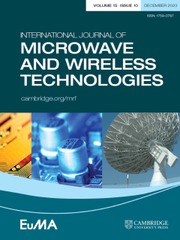Optimization of a wideband antipodal Vivaldi antenna with metalenses
Published online by Cambridge University Press: 05 October 2023
Abstract
A wideband antipodal Vivaldi antenna has been designed and optimized. A slight improvement is obtained by employing multiple metalense based on circular split-ring resonators to maximize the antenna gain with the maximum bandwidth. The designed antennas have been fabricated and characterized, showing good agreement with simulations. The maximum measured gain is  $G = 12\;{\textrm{dB}}$, and the −10 dB bandwidth is from
$G = 12\;{\textrm{dB}}$, and the −10 dB bandwidth is from  $f = 3\;{\textrm{GHz}}$ to
$f = 3\;{\textrm{GHz}}$ to  $f = 13\;{\textrm{GHz}}$.
$f = 13\;{\textrm{GHz}}$.
- Type
- MMS 2022 Special Issue
- Information
- International Journal of Microwave and Wireless Technologies , Volume 16 , Special Issue 1: MMS 2022 Special Issue , February 2024 , pp. 41 - 48
- Copyright
- © The Author(s), 2023. Published by Cambridge University Press in association with the European Microwave Association
References
Loconsole, AM, Portosi, V, Francione, VV, Roberto, G, Anelli, F and Prudenzano, F (2022) Wideband antipodal Vivaldi antenna with metalenses for GPR applications. In 2022 Microwave Mediterranean Symposium (MMS), Pizzo, Italy.Google Scholar
Natarajan, R, George, JV, Kanagasabai, M and Kumar Shrivastav, A (2015) A compact antipodal Vivaldi antenna for UWB applications. IEEE Antennas and Wireless Propagation Letters 14, 1557–1560.10.1109/LAWP.2015.2412255CrossRefGoogle Scholar
Hood, AZ, Karacolak, T and Topsakal, E (2008) A small antipodal Vivaldi antenna for ultrawide-band applications. IEEE Antennas and Wireless Propagation Letters 7, 656–660.10.1109/LAWP.2008.921352CrossRefGoogle Scholar
Fei, P, Jiao, Y-C, Hu, W and Zhang, F-S (2011) A miniaturized antipodal Vivaldi antenna with improved radiation characteristics. IEEE Antennas and Wireless Propagation Letters 10, 127–130.Google Scholar
Gjokaj, V, Papapolymerou, J, Albrecht, JD, Wright, B and Chahal, P (2020) A compact receive module in 3-D printed Vivaldi antenna. IEEE Transactions on Components, Packaging, and Manufacturing Technology 10, 343–346.10.1109/TCPMT.2019.2961345CrossRefGoogle Scholar
De Oliveira, AM, Perotoni, MB, Kofuji, ST and Justo, JF (2015) A palm tree antipodal Vivaldi antenna with exponential slot edge for improved radiation pattern. IEEE Antennas and Wireless Propagation Letters 14, 1334–1337.10.1109/LAWP.2015.2404875CrossRefGoogle Scholar
Puskely, J, Lacik, J, Raida, Z and Arthaber, H (2016) High-gain dielectric-loaded Vivaldi antenna for Ka-band applications. IEEE Antennas and Wireless Propagation Letters 15, 2004–2007.10.1109/LAWP.2016.2550658CrossRefGoogle Scholar
Shi, X, Cao, Y, Hu, Y, Luo, X, Yang, H and Ye, LH (2021) A high-gain antipodal Vivaldi antenna with director and metamaterial at 1–28 GHz. IEEE Antennas and Wireless Propagation Letters 20, 2432–2436.10.1109/LAWP.2021.3114061CrossRefGoogle Scholar
Portosi, V, Loconsole, AM and Prudenzano, F (2020) A split ring resonator-based metamaterial for microwave impedance matching with biological tissue. Applied Sciences 10, .10.3390/app10196740CrossRefGoogle Scholar
Caloz, C and Itoh, T (2006) Electromagnetic Metamaterials: Transmission Line Theory and Microwave Applications. Hoboken, NJ: Wiley & IEEE Press.Google Scholar
Mustacchio, C, Boccia, L, Arnieri, E and Amendola, G (2021) A gain levelling technique for on-chip antennas based on split-ring resonators. IEEE Access 9, 90750–90756.10.1109/ACCESS.2021.3091777CrossRefGoogle Scholar
Portosi, V, Loconsole, AM, Valori, M, Marrocco, V, Bonelli, F, Pascazio, G, Lampignano, V, Fasano, A and Prudenzano, F (2022) Refinement of a microwave needle applicator for cancer therapy via metamaterials. In 2022 Microwave Mediterranean Symposium (MMS), Pizzo, Italy.10.1109/MMS55062.2022.9825526CrossRefGoogle Scholar
Attivissimo, F, Lanzolla, AML, Carlone, S, Larizza, P and Brunetti, G (2018) A novel electromagnetic tracking system for surgery navigation. Computer Assisted Surgery 23, 42–52.10.1080/24699322.2018.1529199CrossRefGoogle ScholarPubMed
Smith, DR, Vier, DC, Koschny, T and Soukoulis, CM (2005) Electromagnetic parameter retrieval from inhomogeneous metamaterials. Physical Review E 71, .10.1103/PhysRevE.71.036617CrossRefGoogle ScholarPubMed
Szabo, Z, Park, G-H, Hedge, R and Li, E-P (2010) A unique extraction of metamaterial parameters based on Kramers–Kronig relationship. IEEE Transactions on Microwave Theory and Techniques 58, 2646–2653.10.1109/TMTT.2010.2065310CrossRefGoogle Scholar
Li, X, Zhou, H, Gao, Z, Wang, H and Lv, G (2017) Metamaterial slabs covered UWB antipodal Vivaldi antenna. IEEE Antennas and Wireless Propagation Letters 16, 2943–2946.10.1109/LAWP.2017.2754860CrossRefGoogle Scholar
Chen, L, Lei, Z, Yang, R, Fan, J and Shi, X (2015) A broadband artificial material for gain enhancement of antipodal tapered slot antenna. IEEE Transactions on Antennas and Propagation 63, 395–400.10.1109/TAP.2014.2365044CrossRefGoogle Scholar
- 1
- Cited by



